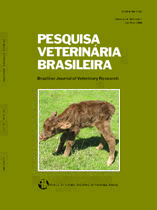 |
|
|
|
Year 2013 - Volume 33, Number 4
|

|
Prevalence and epidemiological, pathological and immunohistochemical aspects of primary canine malignant hepatic tumors in Rio Grande do Sul, Brazil (1965-2012), 33(4)497-511
|
ABSTRACT.- Flores M.M., Bianchi R.M., Kommers G.D., Irigoyen L.F., Barros C.S.L. & Fighera R.A. 2013. [Prevalence and epidemiological, pathological and immunohistochemical aspects of primary canine malignant hepatic tumors in Rio Grande do Sul, Brazil (1965-2012).] Prevalência e achados epidemiológicos, anatomopatológicos e imuno-histoquímicos dos tumores hepáticos malignos primários de cães da Região Central do Rio Grande do Sul (1965-2012). Pesquisa Veterinária Brasileira 33(4)497-511. Departamento de Patologia, Universidade Federal de Santa Maria, Av. Roraima 1000, Camobi, Santa Maria, RS 97105-900, Brazil. E-mail: anemiaveterinaria@yahoo.com.br
The prevalence and epidemiological and immunohistochemical aspects of primary hepatic malignant tumors (PHMT) were reviewed in dogs necropsied in a 48-year period (1965-2012). Out of those7,373 dogs, 64 died due to PHMT, which corresponds to 0.9% of the dogs dying from any cause in the period; 7.8% of dogs which deaths were caused by tumors in general; and 33.5% of all dogs dying from hepatic tumors (primary and metastatic). Out of the 64 cases of PHMT, 51 were reviewed histologically and evaluated by immunohistochemistry; they were diagnosed as carcinomas (36 cholangiocarcinomas, 9 hepatocellular carcinomas and one hepatocholangiocarcinoma) and sarcomas (5 hemangiosarcomas). In those dogs in which the age was possible determined, 64.7% (cholangiocarcinomas) and 77.8% (hepatocellular carcinomas) were old. At necropsy examination cholangiocarcinomas were characterized mainly by a multinodular pattern (83.3%) while hepatocellular carcinomas occurred both as massive (44.4%) or nodular (44.4%) distribution. Extra-hepatic metastasis occurred respectively in 77.8% and 33.3% of the cases of cholangiocarcinomas and hepatocellular carcinomas; metastatic cholangiocarcinomas affected mainly the lungs (52.8%), lymph nodes (50%) and peritoneum (19.4%). Ascites (22.2%) and icterus (22.2%) were observed frequently associated to both tumors. Histologically, most part of the cholangiocarcinomas (86.1%) and of the hepatocellular carcinomas (55.6%) presented respectively a tubular or trabecular type. Immunohistochemistry revealed that the majority (63.9%) of cholangiocarcinomas was positive for CK7 and none was marked for Hep Par 1. The majority (55.6%) of the hepatocellular carcinomas revealed positive reaction for Hep Par 1 and none was marked for CK7. The results presented here demonstrated a very high prevalence of PHMT, especially cholangiocarcinomas, in the dog. The necropsy, histological and immunohistochemical findings reported might be useful to help veterinary pathologists in the diagnosis of this common form of cancer in dogs of the Rio Grande do Sul, Brazil. |
| |
|
|
| |
|
 |